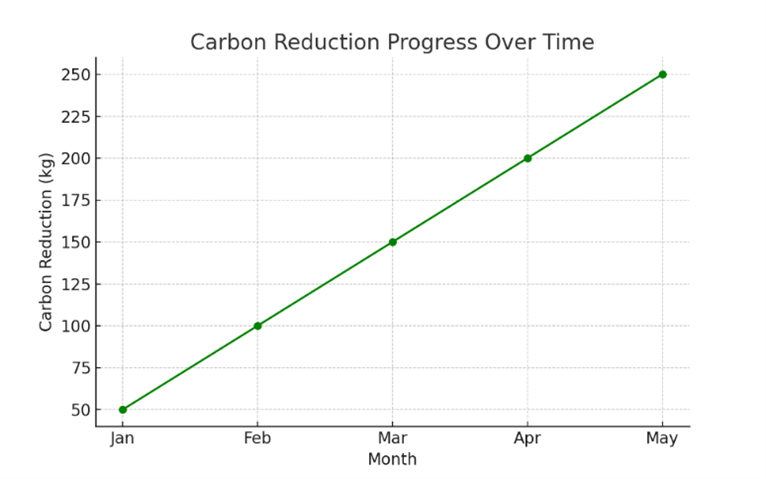AI-Powered Apps for Climate Impact Reduction
AI-Powered Solutions ?? Comments 23/Sep/2025 TueAI-powered apps use advanced algorithms to help individuals and households reduce their environmental impact. These tools analyze lifestyle habits, calculate carbon footprints, and provide personalized strategies to reduce emissions. By leveraging AI, users can make informed decisions for a more sustainable future. Below are practical steps for integrating AI-powered apps into everyday efforts to reduce climate impact.
Practical Steps
-
Use Apps Like Joro to Calculate Your Carbon Footprint and Provide Tailored Reduction Strategies
-
Joro: Joro is an AI-powered app designed to help users measure, understand, and reduce their carbon footprint. It tracks spending patterns, analyzes lifestyle habits, and translates these activities into a detailed carbon emissions profile.
-
Features:
-
Automatically calculates your carbon footprint by linking to your credit or debit card and analyzing spending in categories such as travel, food, and energy.
-
Provides actionable tips to reduce emissions, such as eating less meat, using public transportation, or investing in renewable energy.
-
Offers carbon offset options, allowing users to support verified climate projects to neutralize unavoidable emissions.
-
Example: If Joro detects high emissions from frequent air travel, it might suggest alternative transportation methods, purchasing carbon offsets, or consolidating trips to reduce environmental impact.
-
-
Other Apps:
-
Pawprint: Similar to Joro, Pawprint helps users track their environmental impact and provides a personalized action plan to reduce emissions. It also gamifies sustainability efforts by awarding points for completing eco-friendly actions.
-
Capture: This app focuses on tracking emissions from daily activities like commuting and offers live feedback to help users make greener choices in real time.
-
-
Identify High-Impact Areas in Your Lifestyle
-
AI-powered apps provide detailed breakdowns of your carbon footprint by category, such as transportation, food, energy use, and shopping.
-
Transportation: Apps may highlight the emissions associated with frequent car use or air travel and suggest alternatives like carpooling, public transit, or biking.
-
Food: If emissions from food consumption are high, the app might recommend reducing meat and dairy intake or choosing locally sourced, seasonal produce.
-
Energy Use: For households with high energy consumption, apps like Joro may suggest switching to renewable energy providers or installing energy-efficient appliances.
-
-
Set Climate Goals and Track Progress
-
AI-powered apps help users set achievable sustainability goals, such as reducing their carbon footprint by a certain percentage over time.
-
The app provides actionable steps to meet these goals, such as reducing single-use plastics or switching to green energy suppliers.
-
Progress tracking ensures users stay motivated by visualizing their impact, such as the total emissions reduced or the equivalent number of trees saved.
-
-
Participate in Carbon Offset Programs Through AI Apps
-
Many AI-powered apps allow users to offset their unavoidable carbon emissions by contributing to verified climate projects.
-
Projects may include reforestation, renewable energy development, or methane capture initiatives.
-
Example: If Joro calculates that your monthly carbon footprint is 2 metric tons, it may recommend offsetting this by supporting a solar energy project that reduces equivalent emissions.
-
-
Gamify Climate Impact Reduction Efforts
-
Some AI apps use gamification to make reducing your climate impact more engaging and fun.
-
Apps like Pawprint award points or badges for completing eco-friendly actions, such as using reusable bags or reducing energy usage.
-
These gamified elements encourage consistent behavior changes and make sustainability efforts more rewarding.
-
-
Learn from Community Insights and Comparisons
-
Many apps offer features that allow users to compare their carbon footprints with others in their community or peer group.
-
For example, Joro enables users to join teams and track collective progress toward sustainability goals.
-
This social aspect fosters accountability and encourages collaboration in tackling climate change.
-
-
Use AI to Predict and Plan for Climate-Friendly Choices
-
AI apps often use predictive analytics to help users anticipate the climate impact of future decisions. For instance:
-
Before booking a flight, an app might show the carbon emissions associated with the trip and recommend alternative modes of travel.
-
For meal planning, the app might suggest recipes with low-carbon ingredients and provide local shopping recommendations.
-
Key Benefits of AI-Powered Climate Impact Apps
-
Personalized Insights: AI analyzes individual habits to provide tailored recommendations, ensuring users focus on the most impactful changes.
-
Data-Driven Decisions: By quantifying carbon emissions, these apps give users a clear understanding of how their choices affect the environment.
-
Motivation Through Visualization: Progress tracking and visual metrics keep users motivated to reduce their climate impact over time.
-
Accessibility: AI-powered apps simplify sustainability by offering clear, actionable steps that fit into everyday life.
-
Community Engagement: Many apps foster a sense of community, encouraging users to work together toward collective climate goals.
-
Carbon Offsets Made Easy: These apps streamline the process of offsetting emissions by connecting users with verified climate projects.
By integrating AI-powered apps like Joro into their daily routines, individuals can gain valuable insights into their carbon footprint, adopt sustainable practices, and contribute meaningfully to climate change mitigation.
Example: A homeowner reduced their footprint by switching to eco-friendly transportation based on AI recommendations.
